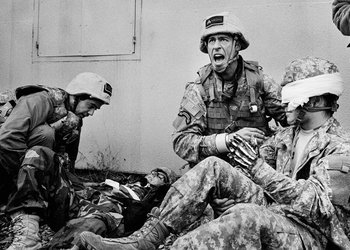
It takes a tremendous amount of stillness and calm to hear someone as they wish to be heard, putting aside every distracting thought, sound, and sight to be in that moment with them.
At the Uniformed Services University of the Health Sciences F. Edward Hébert School of Medicine (USU), our students learn quite a lot about stillness, calm, and how to truly hear someone. That they can be still and hear over the concussive sounds of gunfire, explosions, and the chop of helicopters perhaps makes them a little bit extraordinary.
Students start their military journey with our basic officer course, then move on to the sixteen-month integrated basic science curriculum. It is during these formative months that students learn to take medical histories from World War II veterans, train to insert a chest tube, and discuss how to operate in a humanitarian disaster scenario — all while mastering the material that medical students everywhere are required to learn.
The curriculum continues as students enter their clerkship year, rotating at Military Treatment Facilities stretching from Hawaii to North Carolina, and places in between. Along the way, they participate in the Antietam road march, where they learn about the Civil War’s incredible medical advances; sharpen their skills with Summer Operational Experiences at places like the Navy’s vaunted Top Gun training grounds; and demonstrate their growing trauma mastery with the third-year Operation Gunpowder.
And then they proceed to Operation Bushmaster during the final year, the capstone experience for medical students at USU. Each year, first- and fourth-year learners deploy with nursing and psychology students in the Pennsylvania woods for a full-scale, hands-on medical field exercise wherein they roleplay as patients, physicians, and triage officers making life and death decisions. That the training feels real is attested to by the pain that ghosts a student’s eye as she loses a patient, and the gasp of relief her counterparts exhale when they make a save.
It’s a lot to ask of anyone, while perhaps not quite enough to ask of those destined to take care of America’s sons and daughters. It’s the beginning of a dual calling — to be a healer and a defender, an officer and a physician. It is the most challenging, demanding curriculum in American medicine. It tests nerves and resolve while sleep deprivation and sometimes freezing temperatures whisper, “You can’t do this” and “Why don’t you just let this one go and give up?”
Our students persevere and thrive, and that earns them the right to be called one of us: an officer and a physician.
_______
Article contributed by Aaron Saguil MD, MPH, FAAFP, LTC(P), MC, USA; Associate Dean, Recruitment and Admissions, F. Edward Hébert School of Medicine Uniformed Services University
Editor’s note: The Uniformed Services University of the Health Sciences F. Edward Hébert School of Medicine is the only fully federally funded medical school. Students do not pay tuition, and in return, receive a salary exceeding $64,000 yearly and spend seven years as a physician in the Armed Forces or Public Health Service after completing their residency.